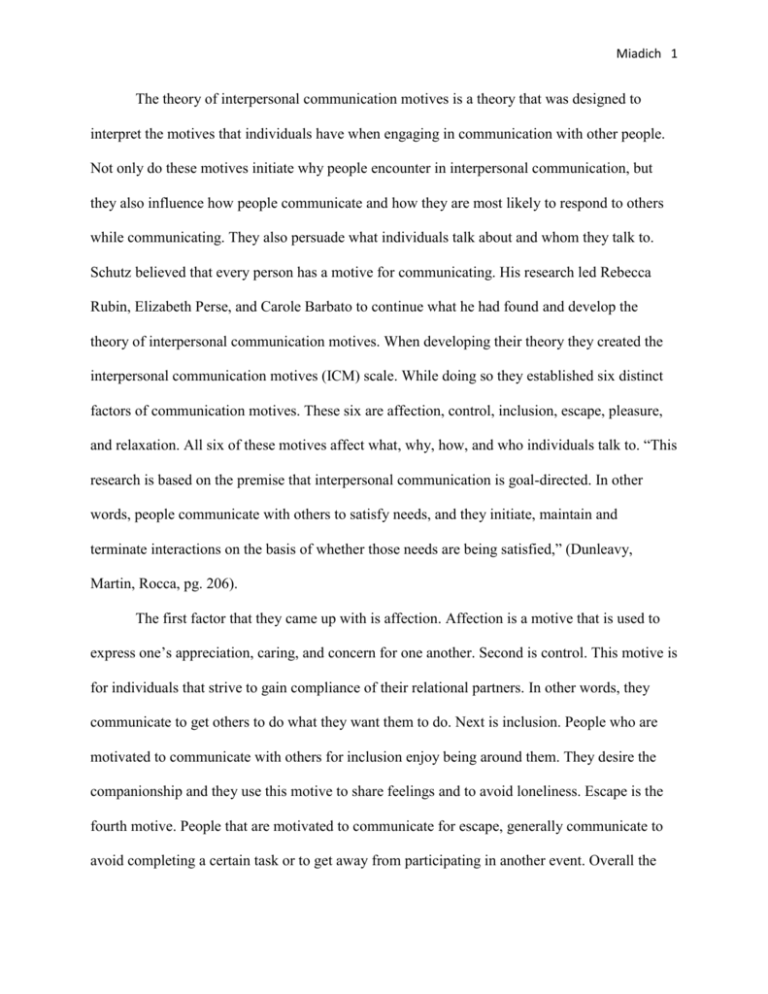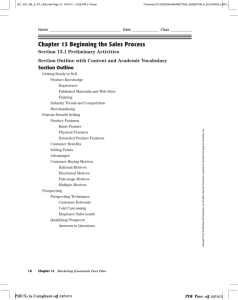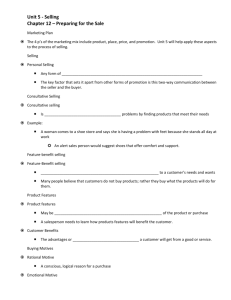Miadich The theory of interpersonal communication motives is a
advertisement

Miadich 1 The theory of interpersonal communication motives is a theory that was designed to interpret the motives that individuals have when engaging in communication with other people. Not only do these motives initiate why people encounter in interpersonal communication, but they also influence how people communicate and how they are most likely to respond to others while communicating. They also persuade what individuals talk about and whom they talk to. Schutz believed that every person has a motive for communicating. His research led Rebecca Rubin, Elizabeth Perse, and Carole Barbato to continue what he had found and develop the theory of interpersonal communication motives. When developing their theory they created the interpersonal communication motives (ICM) scale. While doing so they established six distinct factors of communication motives. These six are affection, control, inclusion, escape, pleasure, and relaxation. All six of these motives affect what, why, how, and who individuals talk to. “This research is based on the premise that interpersonal communication is goal-directed. In other words, people communicate with others to satisfy needs, and they initiate, maintain and terminate interactions on the basis of whether those needs are being satisfied,” (Dunleavy, Martin, Rocca, pg. 206). The first factor that they came up with is affection. Affection is a motive that is used to express one’s appreciation, caring, and concern for one another. Second is control. This motive is for individuals that strive to gain compliance of their relational partners. In other words, they communicate to get others to do what they want them to do. Next is inclusion. People who are motivated to communicate with others for inclusion enjoy being around them. They desire the companionship and they use this motive to share feelings and to avoid loneliness. Escape is the fourth motive. People that are motivated to communicate for escape, generally communicate to avoid completing a certain task or to get away from participating in another event. Overall the Miadich 2 escape motive is engaging in other activities to “fill in the time.” Then there is the pleasure motive. Within the pleasure motive, individuals find communication to be fun and entertaining. They use it for social benefits and stimulation. Finally, the last motive is relaxation. Individuals who engage in communication for relaxation use communication as a way to unwind and rest. Out of these six motives, four of them can be considered more relationally orientated motives which are used to facilitate interaction with others. Those four are pleasure, affection, relaxation, and inclusion. The other two, control and escape, are considered to be used more as personal influence motives and to manage interactions with others. “Each of the motives comprising the ICM emphasizes communicating for voluntary reasons and to fulfill personal needs,” (Fowler, pg. 53). In addition to this theory, Rubin, Perse, and Barbato come up with the ICM scale. The ICM scale is a 28-item scale that asks respondents to indicate the degree to which they are motivated to communicate for the six motives that have been earlier discussed. This scale is solicited using a five-point Likert scale. All questions start off with the phrase, “I talk to people…” then the respondent fills in the blank with an answer ranging from; exactly like me, a lot like me, somewhat like me, not much like me, or not at all like me. The results from the scale will explain out of the six motives why that particular person engages in interpersonal communication. There are many factors that influence a person’s reasoning for communicating. Studies have been previously done that show gender, age, and culture can play a role of a person’s choice to communicate. For instance, women have been known to communicate more to show their affection, whereas as men generally engage in communication to feel a sense of control. Throughout this paper, my research will go into specific studies that have been done and added on to this theory on why people employ in interpersonal communications. Miadich 3 When researching my theory I came across many studies done on siblings and what their motives are for communicating with each other. Kelly A. Rocca, Matthew M. Martin, and Katie Neary Dunleavy said that the sibling relationship is an involuntary one that individuals often maintain throughout life. Knowing this, they came up with an experiment to further investigate why it is that siblings communicate. “The authors found differences between male and females participants and between intact and nonintact families. The number of siblings and the birth order of siblings also appeared to affect motives for communicating,” (Dunleavy, Martin, Rocca pg. 205). Their method consisted of have 323 undergraduate students to participate that had at least one sibling. They were required to take the ICM scale which each question began with “I talk to my sibling…” Eight of the items measure pleasure, five for affection, four for inclusion, four for relaxation, four for escape, and three for control. In the results there were four dyads; male to brother, male to sister, female to brother, and female to sister. The results showed that motives based on the gender differences, women communicated more with their brothers and sisters for affection than men did with their brothers or sisters. For inclusion, women communicated with their sisters more than any other dyads shown. Moving on, the motives based on intact families versus nonintact families, the main difference was the pleasure motive. Siblings that were in intact families did not report communication for pleasure as much as siblings within nonintact families. The third question they tested was if siblings with only one other sibling differed from participants with more than one sibling. The control motive was higher for participants with only one sibling whereas participants with more than one sibling had a higher motive in communicating for relaxation and pleasure. Then the last question that they looked at was whether or not siblings that were the Miadich 4 oldest differed from siblings that were not the oldest. Their results showed that the oldest siblings communicated more for control then younger siblings did. Then, younger siblings communicated more for pleasure, relaxation, and inclusion. “Although people have no choice in selecting their siblings, people do decide, especially once they reach adulthood, how, when, and why they communicate with their siblings,” (Dunleavy, Martin, Rocca pg. 214). In conclusion of their experiment the authors wanted to make known that all participants were in college so therefore the study should not be generalized to all other populations. As well as only one sibling’s response was asked for, rather than both. Considering these circumstances other studies would need to be done in the future to find out the results of other populations. Another study has been done on siblings based off of the interpersonal communication motives theory by Craig Fowler. Unlike the previous study discussed, his study focused more just on siblings and their ages and genders, and their motives to communicate across the lifespan. There is an important role that siblings play on each other’s lives whether it is during adolescence for mutual comfort, or moving into adulthood and to ally parent-child conflicts. Throughout the lifespan many siblings will remain close and vital to one’s life, but never before was it ever studied on why and what their motives are for staying connected and communicating. Strong sibling relationships have a positive impact on anybody no matter what age or gender they are. However, Fowler discusses that in old age, having a strong tie with your sibling has the most positive impact. “Frequent contact with a sibling in later life appears to have a positive impact on the well-being of older persons, as siblings provided crucial support to one another in times of crisis,” (Fowler pg. 52). There are many reasons that Fowler gives throughout his study on why it is important to understand the reasoning of the motives that siblings have for communicating. One reason is that Miadich 5 the motives shape the nature of any encounter that takes place. They decide what the conversations are about and how thoroughly and in depth they are discussed. Going even further, they shape what is accomplished throughout the interaction. Then lastly, if we know why they are motivated to communicate with their siblings then we might understand why some siblings derive greater pleasure from their relationships than others. The participants in the study were split into categories by age; 18-34, 35-49, 50-64, and 65 and up. Each participant had to have at least one sibling and if they had more than one, while doing the study they had to focus solely on one of their siblings. There were also many participants both male and female and several different races were recorded. The instrument used was the ICM scale as earlier discussed asking all questions relating to how closely each statement reflected their reasons for communicating with their sibling. The motives used for this study were remotely close to the original motives; these ones were comfort, control/escape, intimacy, obligation, and mutuality. The results showed the strongest to least endorsed communication motives were intimacy, comfort, mutuality, obligation, and then control/escape. Looking at the age differences, only one motive showed a significant difference which was the control and escape motive. The age group of 18-34 put down they communication for control or escape almost double the amount that any other age group put down. All other four motives were generally rated close to the same. All together, this study shows that life stage and gender are both influencers on sibling motives to communicate. “We found that the motives reported to be most salient for siblings were relational in nature (intimacy and comfort), whereas the least salient motive were control/escape and obligation. We found only limited variation in motives as a function of age,” (Fowler pg. 61). Looking at this study it is interesting to see that there is no evidence that older Miadich 6 siblings feel more obligated than desired to communicate with their siblings. In conclusion of Fowler’s study, intimacy was the primary motive for communication of siblings at each life stage. Still looking at family communication, a study was done by Carole A. Barbato, Elizabeth E. Graham, and Elizabeth M. Perse on the motives for why parents communicate with their children. Also they looked at the differences between mothers and fathers and if each parent communicated with their sons and daughters for different reasons. The study was done using 258 parents with children under the ages of 17. As all studies done based off of this theory, the parents took the ICM scale with their children in mind. The first hypothesis that the authors came up with and was found to be true was that mothers and fathers employ relationally oriented motives such as affection, inclusion, and pleasure when communicating with their children. Among the six motives there were wide ranges between each one when the results came back. The main motive that parents communicate with their children for is affection. The second motive was pleasure, then relaxation, inclusion, control and escape. These results were for parents in general, including both mothers and fathers. Next the authors looked at the gender differences between mothers and fathers and why they communicate with their children. Also they tested if mothers and fathers communicated with their sons for different reasons then they do with their daughters. To finish their study they found out that fathers’ motives for communicating were mainly for pleasure; to play and for amusement. Then mothers’ motives for communicating were based on inclusion, they sometimes think of it as the need to be with others to overcome loneliness. Mothers also communicate more for control than fathers do. When looking at the escape motive fathers use escape more with their sons to get away from the pressures of work, whereas mothers use the escape motive more when Miadich 7 communicating with their daughters. The last part of information that the authors found when doing this study is that both parents communicate with older children more for the need of inclusion while they communicate with younger children for affection and pleasure. Overall this study done by Barbato, Graham, and Perse showed that parents communicate with their children for more relationally orientated motives specifically affection, pleasure, and inclusion. Moving on to other relationships other than those within families, I continued my research with college students and their instructors. Matthew M. Martin, Scott A. Myers, and Timothy P. Mottet came up with a study to find out what motivates college and university students to communicate with their professors. To go about this study they invented an experiment where a number of students first anonymously filled in the blank on why they communicate with their instructors. From this they received 54 different responses which led them to the second part of the experiment. Another group of students received a survey with these 54 answers included and they were required to indicate which ones related to them when communicating with professors. They also received an ICM scale to fill out as well to base on their motives in general for communicating, not only for their instructors. When looking at the results of the ICM scale the six motives ended up in this order starting with the motive that students used the most; pleasure, affection, inclusion, escape, relaxation, and control. Using the survey involving the 54 responses, the authors came up with five additional motives to why students communicate with instructors. These five motives were relational, functional, excuse, participation, and sycophancy. Relational is referred to as a motive to develop personal relationships with their professors. Functional is a motive that is about wanting to learn the material that is in class and the assignments that go along with it. Next is excuse which is students use excuses as to why their homework is being turned in late or not Miadich 8 turned in at all; also to try and challenge a grade that they received. Then there is participation. This motive is to show that they are interested in class and they understand what is being taught. The last motive was sycophancy which is they communicate to give a favorable impression. Within this motive, students communicate in a way that they know the instructor will approve. Along with these results, Martin, Myers, and Mottet found that students that communicate for all of the interpersonal communication motives tend to communicate more to relate and participate and less for excuse and sycophancy. On the other hand, students that communicate more for control, communicate with instructors more for excuses and sycophancy. All together it is important to understand these communication motives in order to understand the development of a functional model of communication. Each factor in this theory represents a motivation or reason for interpersonal communication. After reviewing the six motives; affection, pleasure, inclusion, control, escape, and relaxation I believe that all people no matter what age, gender, or race communicate for all six of these reasons to some extent. Some of the six may be used more than others, but at some point in time, I firmly believe that we are all motivated to communicate for each of these six reasons. The theory of interpersonal communication motives was developed in 1988 in correlation to the functional approach to interpersonal communication, the theory of interpersonal needs, and the media uses and gratifications theory. These motives have been employed in a variety of different contexts. Some contexts where they have been engaged in are small groups, families, instructional settings, and all together any age group. The motives are what set the tone for interpersonal interaction. This research paper discussed many different studies that have been previously done from siblings, parents and children, and students and instructors. For my Miadich 9 prospectus part of this part I have decided to develop a hypothesis and method for another type of relationship that no studies have been found on. This leads me to my hypothesis which is based on college roommates. My hypothesis is that throughout a students’ freshmen year of college, his/her motives will change from the beginning of the year to the end of the year on why they engage in interpersonal communication. Some requirements for this study is that the student must be a freshman and living on campus and also they cannot have known their roommate prior to starting school. This way it will eliminate the outliers that motives stay the same throughout the year because they already knew each other. This study will consist of around 200 freshman students or more or less depending on how willing the students are to continue this throughout the entire school year. The participants will remain anonymous so therefore one or both of the roommates may be involved in the study, but it would not be known. For my method I will be using the interpersonal communication motives scale starting off each question with “I talk to my roommate because…” Each participant will receive the scale after the first week of classes. This would have given them enough time to have several encounters with their roommate where they can answer the questions on the scale efficiently. The second time they receive the scale will be at the end of the first semester. Then finally, the last time that they receive it will be at the end of the school year before finals. Once the results are in I will be able to calculate and prove whether my hypothesis was true or not on whether or not college freshmen roommates motives for communicating with each other change as the year goes on. Miadich 10 Below I have included a possible ICM scale that I could use to test out my hypothesis. Note that each participant would rank these statements based on “I talk to my roommate…” with 1 being the lowest and 5 being the highest. Because it’s stimulating Because it peps me up Because we share the same room Because it’s reassuring to know someone is there Because I need someone to talk to or be with Because it makes me feel less lonely Because I do not know anyone else Because it makes me feel less tense Because it allows me to unwind Because it relaxes me To get away from pressures and responsibilities Because I want them to do something for me To get something from them I don’t have To tell him=her what to do Because I have nothing better to do To get away from=put off something I should be doing Because I need their help with something Because I enjoy it To show him=her encouragement Because they are always around Because I’m concerned about them or want to help them To let him=her know I care about how they are feeling Because I want to maintain our relationship Because they=someone else makes me feel we should talk Because I feel an obligation to talk to them Because speaking to them is a habit Because it’s part of our routine Because there are things we need to accomplish together To get information from them





